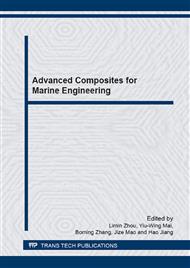[1]
L.D.R. Grant, R.D. Adams, L.F.M. da Silva. Effect of the temperature on the strength of adhesively bonded single lap and T joints for the automotive industry. Int. J Adhes. Adhes. . 29 (2009) 535-542.
DOI: 10.1016/j.ijadhadh.2009.01.002
Google Scholar
[2]
Y.G. Kim, S.J. Lee, D.G. Lee, K.S. Jeong. Strength analysis of adhesively-bonded tubular single lap steel-steel joints under axial loads considering residual thermal stresses. 60 (1997) 125-140.
DOI: 10.1080/00218469708014414
Google Scholar
[3]
M. R. Far, J. Absi, G. Mariaux, S. Shahidi. Effect of residual stresses and prediction of possible failure mechanisms on thermal barrier coating system by finite element method. J. Therm. Spray Technol. . 19 (2010) 1054-1061.
DOI: 10.1007/s11666-010-9512-1
Google Scholar
[4]
J Coppendale, The stress and failure analysis of structural adhesive joints. PhD thesis, Department of Mechanical Engineering, University of Bristol, UK, (1977).
Google Scholar
[5]
M. Ranjbar far, J. Absi, G. Mariaux, and F. Dubois, Simulation of the effect of material properties and interface roughness on the stress distribution in thermal barrier coatings using finite element method, Mater. Des. . 31 (2009) 772-781.
DOI: 10.1016/j.matdes.2009.08.005
Google Scholar
[6]
G Li, P Lee-Sullivana, RW Thring. Nonlinear finite element analysis of stress and strain distributions across the adhesive thickness in composite single-lap joints. Compos. Struct. . 46 (1999) 395-403.
DOI: 10.1016/s0263-8223(99)00106-3
Google Scholar
[7]
A Deb, I Malvade, P Biswas, J Schroeder. An experimental and analytical study of the mechanical behaviour of adhesively bonded joints for variable extension rates and temperatures. Int. J Adhes. Adhes. . 28 (2008) 1–15.
DOI: 10.1016/j.ijadhadh.2007.02.004
Google Scholar
[8]
VK Srivastava. Characterization of adhesive bonded lap joints of C/C-SiC composite and Ti-6Al-4V alloy under varying conditions. Int. J Adhes. Adhes. . 23 (2003) 59–67.
DOI: 10.1016/s0143-7496(02)00082-9
Google Scholar
[9]
LDR Grant, RD Adams, LFM da Silva. Effect of the temperature on the strength of adhesively bonded single lap and T joints for the automotive industry. Int. J Adhes. Adhes. . 29 (2009) 535–42.
DOI: 10.1016/j.ijadhadh.2009.01.002
Google Scholar
[10]
LFM da Silva, RAM Silva, JAG Chousal, AMG Pinto. Alternative methods to measure the adhesive shear displacement in the thick adherend shear test. J. Adhes. Sci. Technol. . 22 (2008) 15–29.
DOI: 10.1163/156856108x292241
Google Scholar


